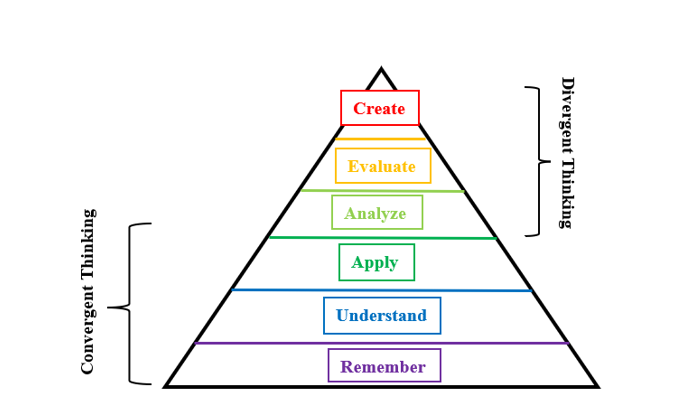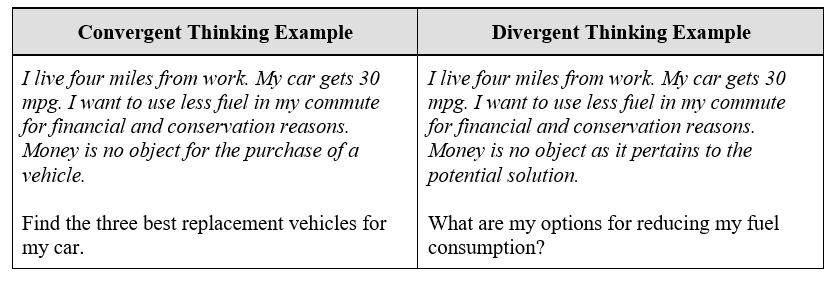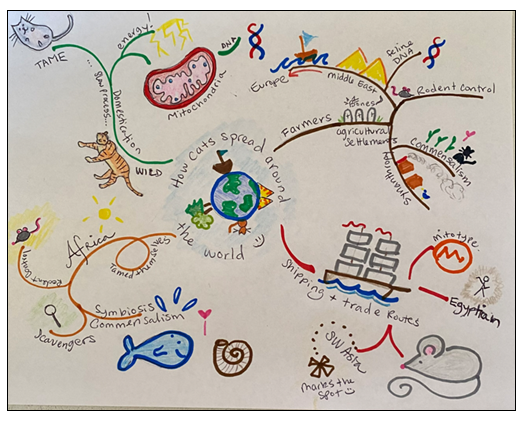Executive Functions: Focused Interventions for Shift Deficits

As teachers, we have all experienced students who have trouble switching gears. For a variety of reasons, any change to a schedule might make them anxious or angry. When they encounter open-ended problems, their stress levels rise considerably because they can only see one possible solution. In essence, they struggle to cope with change and are unable to think creatively.
Students who struggle with cognitive flexibility will undoubtedly experience challenges that typically revolve around not being able to approach problems from different angles or not being able to use different strategies to solve problems. The following is a list of common behaviors that have been associated with deficits in shift, both in school and at home.
- The student may not be accepting of others’ ideas and suggestions.
- The student may argue the same point over and over.
- The student may get frustrated when even small things go wrong.
- The student may repeat the same mistakes.
- The student may have trouble following a new schedule.
- The student may get anxious when plans change.
- The student may struggle to take on new, more complicated tasks.
- The student may have trouble switching from one activity to the next.
- The student may get upset when others don’t follow the rules.
Introducing Students to the Concept of Shift
It is essential for students to learn how to acquire the ability to adapt and shift their approach to understanding, as this affords them the opportunity to take different perspectives into account as they work toward solving unique and novel problems. To put this into perspective, let’s use the complicated example of reading. Meltzer (2010) points out that to be able to successfully read (and thus comprehend), students must first be able to decode with accuracy, precision, and efficiency. This complicated cognitive function requires students to flexibly shift among four different approaches: letter-sound decoding, use of sight word vocabulary, reliance on context clues, and use of examples (Gaskins, 2008).
Wilson and Conyers (2016) have identified several fun ways to introduce students to the concept of shift and cognitive flexibility. They suggest that by sharing the following with students, they will quickly learn to appreciate just how useful and necessary cognitive flexibility is not only to thinking, but to the overall learning process in general.
- When students encounter an unfamiliar word, a great reading strategy is to use their flexible thinking to break it down into smaller, more familiar words. For example, when faced with having to decode the word beachball, students can break it into two separate words (beach and ball). From there, they can determine that the word beachball is a kind of ball that people play with at the beach.
- Like the example above, students can use their flexible thinking to break an unfamiliar word into its corresponding “pieces” by using their knowledge of prefixes, roots, and suffixes. For example, when Stephanie encounters the word portable in her reading, she can use her flexible thinking skills to deconstruct it into port (carry) and able (capable of). From there, she can derive that the word portable means “capable of being carried.”
- If a student experiences a roadblock when trying to remember a long list of items (e.g., the names of the Great Lakes), s/he can use his/her flexible thinking skills and employ the mnemonic HOMES (Huron, Ontario, Michigan, Erie, Superior).
- Teach students a variety of problem-solving strategies and then encourage them to use them regularly. For example, when solving a tough mathematical word problem, encourage students to go through their rolodex (mental or physical) of strategies. If one doesn’t work, encourage them to try a different one. For example, they can draw a picture, use manipulatives, work backwards, or make a table.
- If students get stuck, show them how they can shift their thinking to work on something else. More often than not, this process allows the idea to “percolate” in their working memory. Then, when it’s time to go back, their brains have already sorted through the information, making finding a solution easier. For example, when asked to write an essay, many students with shift problems don’t know where to start. For whatever reason, they can’t get past the fact that they have no idea how to introduce their topic. When this happens, encourage them to shift forward, perhaps working on their middle argument or even the conclusion first. Then, when they are ready to shift back, they will have a better idea of what they want to say.
Convergent vs. Divergent Thinking
Being able to think critically and creatively requires students to use their executive functions, of which shift plays a big role. Cognitive flexibility is indeed a higher-order thinking skill, and it needs to be explored, practiced, and nurtured daily. Also known as HOTS, students’ higher-order thinking skills are related to Bloom’s taxonomy, a hierarchical classification system aimed at the different levels of thinking. According to Rebecca Stobaugh (2019), the first three levels (Remember, Understand, and Apply) often require students to think convergently, while the top three levels (Analyze, Evaluate, and Create) often require students to think divergently (p. 11).

What this means is that convergent thinking goes through a fairly straightforward process to determine a concrete solution to a problem. It focuses on determining the most effective answer to a problem and relies heavily on logic. Convergent thinking typically results in similar answers and therefore does not require students to shift their thinking too much. Divergent thinking, on the other hand, is less of a straightforward process. It involves exploring multiple possibilities to generate creative ideas. While convergent thinking involves speed, accuracy, and logic, divergent thinking tends to be spontaneous, free-flowing, and non-linear. In addition, convergent thinkers typically rely on tried-and-true methods to find solutions, while divergent thinkers use their executive functions to discover new and creative procedures to solve a problem, despite any obstacles to their learning and understanding. These “outside the box” thinkers can easily shift between both modes. The following example illustrates this slight difference (Charron, 2011).

While the problem is the same, the question changes slightly, depending on the point of view. The convergent example asks to find three specific vehicles, whereas the divergent example doesn’t rule out additional possibilities, such as moving closer to work, telecommuting, walking, riding a bike, carpooling, taking public transportation, etc.
In theory, convergent and divergent thinking are two completely different ways of thinking. However, just like higher-order thinking requires a solid foundation in lower-order thinking skills, so too are convergent and divergent thinking inextricably entwined.
Best Practices to Ignite Creativity
Now that you have a better understanding of executive function and shift in particular, it is time to discuss what you can do as a teacher to spark your students’ creativity, regardless of whether they have executive deficits. The following seven strategies are designed to encourage students to dig deeper into their higher-order thinking skills so that they can successfully operate at the highest level of Bloom’s taxonomy.
- Brainstorming. In terms of executive function (and creativity in particular), brainstorming is perhaps one of the best techniques to stimulate students’ ideas, no matter how far-fetched they may seem. Brainstorming is an excellent teaching activity when its purpose is to generate ideas on a given topic.
In its initial stages, brainstorming has three steadfast rules which cannot be broken.
- Everyone has a say.
- All ideas carry the same amount of weight.
- Students are not allowed to criticize or validate any of the ideas that are generated.
Brainstorming provides students with the opportunity to shift their thinking quickly so that they can generate as many ideas as possible within a set timeframe. As they think of all things related to a concept, they engage their HOTS and stretch their creative-thinking skills.
- Add Movement. According to neuroscientist Dr. Wendy Suzuki (2016), there seems to be evidence which suggests that exercise is tied to shifting and creativity. According to Dr. Suzuki, exercise seems to help people come up with new ideas, which has been shown to equate to creative thinking. Thus, from this research and other studies like it, the evidence points to the fact that physical activity can help engage the creative areas of the brain, allowing people to think differently. Even something as simple as getting students out of their seats for a quick movement/brain break will do wonders in terms of improving their brain function and boosting their executive skills.
If stopping to allow movement breaks throughout the day is not feasible in your classroom, you might want to consider supplying students with some type of fidget object, such as a foot fidget. Remember — many students need movement to spark shift and creativity. Simply tie a resistance band between the front two legs of the student’s desk. This provides a “platform” of sorts, where students can kick or bounce their legs on the band. Not only does this satisfy the need for movement, but it is almost virtually noiseless, and it prevents students from encroaching on their peers’ personal space. For students who need to move their arms, simply tie the resistance band to the back or bottom of the chair. Students can then pull on the band with one or both arms. It is quiet and satisfies the requirements of movement as it relates to the creative-thinking process.
- Mind Maps. A mind map is a diagramming tool that is used to visually organize information. It begins with a single concept which is drawn in the center of a blank landscaped page. A student’s ideas branch out from the center through pictures, symbols, words, and phrases. Major ideas are connected to the central concept or topic, with other ideas branching out from each separate arm. Color plays an important role in that similar branches have similar colors that connect them to the middle, or main, topic. When a mind map is completed, the central concept or topic is surrounded by connected branches of associated subtopics. This visually pleasing format makes it especially easy for students to see connections and shift their thinking.

Mind mapping is a fantastic learning tool because it helps students brainstorm their ideas quickly and creatively. Mind mapping is also beneficial for teachers in that it provides a visual which can be used to gain insight into students’ thought processes. A quick glance at a mind map helps teachers instantly grasp who might need additional assistance and who is ready to run with their idea.
- Practice mindfulness. Mindfulness is the act of bringing one’s full attention to the present, without judgment. Mindfulness activities allow students to focus on the present, effectively shutting out all the other “buzz” which surrounds them. This, in turn, allows students to focus their thoughts and ideas on the task at hand, effectively boosting their divergent thinking. Practicing mindfulness allows students to calm their distracting thoughts which in turn lowers their anxiety and stress levels. This provides the perfect breeding ground to foster ideas and creative insights in a calm and organized manner.
Check out 51 Mindfulness Exercises for Kids in the Classroom which can be immediately used in the classroom. All these strategies are designed to get students to focus on the here-and-now, which paves the way for executive functions to shine.
Helping students learn to shift their thinking and turn on their creativity is a skill worth spending time developing. This type of thinking will serve students as they pass through the grades and even into college and adulthood.
Are you curious? Want to take a deep dive on this topic?
To learn more about the impact of executive function skills and how to use focused interventions to support students in developing their executive function skills, visit the Professional Development Institute (PDI) website or our Focused Interventions to Improve Executive Function Skills course.
For over 27 years, PDI has provided high-quality and affordable online professional development courses to K-12 teachers worldwide. Our online courses are designed to offer practical strategies that can be implemented in classrooms immediately. All our courses are instructor-led and conducted entirely online. Graduate-level university credit for every PDI online course for teachers is available through the University of California San Diego Division of Extended Studies. PDI offers an extensive catalog of online courses that cover the most critical topics in today's classrooms.
Categories: executive function skills, teaching strategies
References:
Charron, P. (Oct. 26, 2011). “Divergent Thinking vs Convergent Thinking.” Think Company. [Blog post]. Retrieved 24 July 2025 from https://www.thinkcompany.com/blog/divergent-thinking-vs-convergent-thinking/
Gaskins, I. W. (2008). “Developing Cognitive Flexibility in Word Reading Among Beginning and Struggling Readers.” In K. B. Cartwright (Ed.) Literacy Processes: Cognitive Flexibility in Learning and Teaching (pp. 90-114). New York, NY: Guildford Press.
Meltzer, L. (2010). Promoting Executive Function in the Classroom. New York, NY: Guilford Press.
Stobaugh, R. (2019). 50 Strategies to Boost Cognitive Engagement: Creating a Thinking Culture in the Classroom. Bloomington, IN: Solution Tree Press.
Suzuki, W.A. (2022). “A neuroscientist says that there’s a powerful benefit to exercise that is rarely discussed.” Retrieved 24 July 2025 from https://qz.com/592569/a-neuroscientist-says-theres-a-powerful-benefit-to-exercise-that-is-rarely-discussed/
Wilson, D. & Conyers, M. (2016). Teaching Students to Drive Their Brains: Metacognitive Strategies, Activities, and Lesson Ideas. Alexandria, VA: ASCD.

View PDI's Catalog of Courses
Check out a list of all PDI graduate-level online courses or sort by grade level or subject area.

Register Now!
Quick access to register for PDI's online courses using our secure system.

Learn More about PDI
Find out how to reach PDI and get answers to any questions you may have.

Access My Course
Access PDI's online learning management system to begin your course.